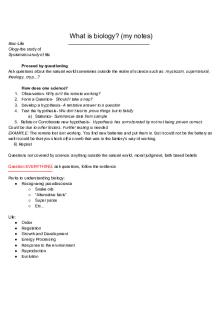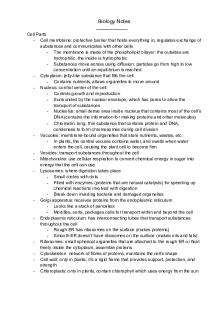Biodiversity - A-Level Biology notes PDF

| Title | Biodiversity - A-Level Biology notes |
|---|---|
| Course | Biology - A2 |
| Institution | Sixth Form (UK) |
| Pages | 2 |
| File Size | 160.3 KB |
| File Type | |
| Total Downloads | 68 |
| Total Views | 173 |
Summary
A-Level Biology notes...
Description
Chapter 10: Biodiversity 10.1 Species and taxonomy Classification: the organisation of living organisms into groups based on a number of accepted principles Species: a basic unit of classification which are capable of breeding to produce living, fertile offspring
Binomial system: - A universal system based upon Latin and Greek names - Genius comes first and is always capitalized; species comes second - Underlined or italicized
Courtship behaviour enables individuals to: - Recognize members of their own species to make sure mating happens within species - Identify a mate that is capable of breeding - Form a pair bond which will lead to successful mating and raising of offspring - Synchronized mating which is when the probability of sperm and egg cells meeting is at its maximum - Become able to breed - Females behave differently when they are at a receptive stage which allows males to know they’re ready to mate. Taxonomy: theory and practice of biological classification. There are 2 forms: 1. Artificial classification divides organisms according to physical appearances but come from different origins. Ex. Wings of a bird and a butterfly are both used for flying but they originated in different ways. 2. Phylogenetic classification is based on evolutionary relationships between organisms and ancestors. It’s classified by shared features derived from their ancestors. The groups are arranged into a hierarchy. o Hierarchy: groups are contained within larger composite groups with no overlap. Domain: Bacteria - Prokaryotes - No nuclei or mitochondria - Smaller ribosome is 70S - Cell walls made of murein - Unicellular - Single loop of DNA 9no histones0 Domain Kingdom Phylum Class Order Family Genus Species
Dear King Phillip Came Over For Good Spaghetti
Archaea - Prokaryotes - Genes and protein synthesis similar to eukaryotes - Membranes contain fatty acids attached to glycerol - More complex form of RNA polymerase
Eukarya - One or more eukaryotic cells - Presence of mitochondria and chloroplasts Membranes contain fatty acids attached to glycerol - Larger ribosomes 80S - 4 kingdoms: protoctista, fungi, plantae and animalia. Within each kingdom the largest groups are known phyla.
Phylogeny: evolutionary relationships between organisms represented in a tree like diagram
10.2 Diversity within a community Biodiversity: variety in the living world
1. Species diversity – number of different species and individuals of each species within a community 2. Genetic diversity – variety of genes possessed by the individual that make up of population 3. Ecosystem diversity – range of different habitats Species richness: the number of different species in a particular area at a given time Index of diversity: to calculate the species diversity of two habitats 10.3 Species diversity and activities Impact of agriculture:
human
Chapter 10: Biodiversity -
Natural ecosystems develop into big communities with many individuals from different species Agricultural ecosystems are controlled by humans. Farmers select specific species to make them more productive therefore the number of alleles that a species possesses is reduced to the desired ones only o Economically desired species need to be produced in large quantities o Therefore there is less space for other species and they have to compete for resources to survive. Most of them will die so the population of the species will decrease therefore the undesired species are removed by pests to reduce competition. o The overall effect is reduction in species diversity and index of species diversity Direct removal of habitats: - Removal of hedgerows - Filling ponds or draining wetlands - Creating monocultures - Overgrazing of land
Balance between conservation and farming: - Food is essential and is in more demand each year therefore the effect of intense food production diminishes variety of habitats within ecosystem which reduces species diversity.
Indirect removal of habitats: - Use of pests or inorganic fertilizers - Absence of crop rotation or lack of intercropping
Conservation techniques: - Reduce the use of pesticides instead use biological control - Use organic fertilizers - Use crop rotation that includes a nitrogen fixing crop to improve soil fertility - Create natural meadows - Use intercropping to control weeds 10.4 Investigating diversity Comparing genetic diversity between species determines evolutionary relationships between them. Comparison of DNA and mRNA base sequences: - Using technology we can accurately determine the exact order of nucleotides in DNA - Each nucleotide is tagged with a different color by the computer - This produces a series of colored bands - By comparing patterns of two species we can tell how diverse they are - Species with similar DNA, are closely related
Comparison of observable characteristics: - Each characteristic is determined by a gene. The variety depends on the number of alleles of the gene and environmental influences - Limitations: there are several genes that code for the same characteristic and they can be modified by the environment therefore scientists can’t know whether it’s the gene or the environment that cause the change.
Comparison of amino acid sequences in proteins: - Once the amino acid sequence for a chosen protein has been determined for 2 species, the 2 sequences are compared. If the two sequences are similar the two species are closely related 10.5 Quantitative investigations of variation Random sampling: taking measurements of individuals selected from the population at random. Due to sample bias and change, chosen individuals fail to represent the population To eliminate sampling bias: - Divide an area into grids - Use random numbers to label each quadrant - Take samples at the intersections
Standard deviation is an indication of the range of values on either side of the mean
-
Interspecific variation differences between two species Intraspecific variation differences within the species
To minimize effect of chance: - Use a large sample size - Use statistical tests to analyze the data collected...
Similar Free PDFs

Essay questions Biology Alevel 9700
- 16 Pages

Unit 1 - Biodiversity - Notes
- 20 Pages

2 Biodiversity - Lecture notes 2
- 33 Pages

Biology Notes
- 7 Pages

Biology Notes
- 16 Pages

Conservation of Biodiversity
- 6 Pages

Fundi Biodiversity Webquest
- 45 Pages

Studoc envr biodiversity
- 2 Pages

Biodiversity under threat
- 8 Pages

Chapter 16 - Biodiversity
- 1 Pages
Popular Institutions
- Tinajero National High School - Annex
- Politeknik Caltex Riau
- Yokohama City University
- SGT University
- University of Al-Qadisiyah
- Divine Word College of Vigan
- Techniek College Rotterdam
- Universidade de Santiago
- Universiti Teknologi MARA Cawangan Johor Kampus Pasir Gudang
- Poltekkes Kemenkes Yogyakarta
- Baguio City National High School
- Colegio san marcos
- preparatoria uno
- Centro de Bachillerato Tecnológico Industrial y de Servicios No. 107
- Dalian Maritime University
- Quang Trung Secondary School
- Colegio Tecnológico en Informática
- Corporación Regional de Educación Superior
- Grupo CEDVA
- Dar Al Uloom University
- Centro de Estudios Preuniversitarios de la Universidad Nacional de Ingeniería
- 上智大学
- Aakash International School, Nuna Majara
- San Felipe Neri Catholic School
- Kang Chiao International School - New Taipei City
- Misamis Occidental National High School
- Institución Educativa Escuela Normal Juan Ladrilleros
- Kolehiyo ng Pantukan
- Batanes State College
- Instituto Continental
- Sekolah Menengah Kejuruan Kesehatan Kaltara (Tarakan)
- Colegio de La Inmaculada Concepcion - Cebu





